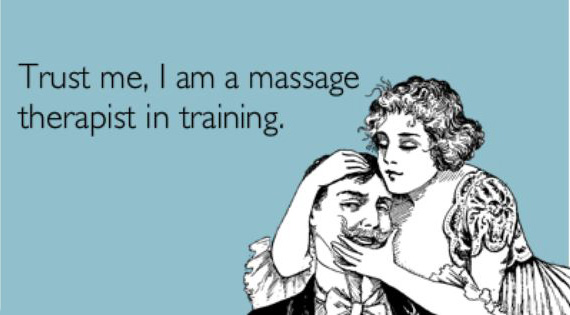Looking for a career in massage therapy? Here are a few tips
One of the most frequent comments massage therapists make about their occupation is “I feel fortunate to have found work I love.” They feel this way because a career in massage therapy allows them to help people in a meaningful way with a high degree of personal contact.
A career in massage therapy provides an opportunity to express very positive values about caring and well-being in their work in a way that is both personally and professionally rewarding.
Massage Therapy Growing as a Career Opportunity
As massage therapy has become increasingly important in the health and wellness professions, the number of massage therapists has risen dramatically. AMTA estimates that the number of massage therapists in the United States, including students, is between 300,000 and 350,000.
There are currently more than 300 accredited massage therapy institutions in the United States. Many institutions have multiple campuses. Training programs in massage therapy generally require a high school diploma, though post-secondary education is useful. Previous studies in broad subjects such as science (especially anatomy and physiology), business and humanities are helpful.
Variations on a career in Massage Therapy
There is no such thing as a standard massage therapy practice. One of the reasons individuals choose this profession is because of the flexibility it offers in terms of work hours, independence, and choice of practice locations and types.
Massage therapists can work full time or part-time. Massage therapists spend additional time on things like scheduling, billing, housekeeping and marketing, to name a few.
Income levels for massage therapists vary by region of the country, experience and type of practice. For more information on the massage therapy profession, check out AMTA’s Industry Fact Sheet.
Settings in Which Massage Therapists Practice
Massage therapists practice in a variety of settings and locations and in a variety of contractual arrangements. Some examples of locations in which massage therapists practice are:
- massage office
- office in home
- physicians’ offices and clinics
- franchises
- hospitals and wellness centers
- nursing homes/hospices
- chiropractic offices
- onsite (chair massage in offices, airports and at public events, for example)
- health clubs and fitness centers
- sports teams and events (amateur and professional)
- hotels
- spas and resorts
- salons
- cruise ships
While massage therapists work in a variety of work environments, sole practitioners account for the largest percentage of practicing therapists (67 percent). Sixty percent work at least part of their time at a client’s home/business/corporate setting, 23 percent in a health care setting, 29 percent in a spa setting and 38 percent at their home. Refer to the Industry Fact Sheet.
The Path to a Career in Massage Therapy
Pursuing a career in massage therapy often involves three steps:
- Complete a training program at a massage therapy school that will qualify you to practice in the location you choose.
- Upon graduation, meet the requirements of your state or municipality (such as obtaining a license or other credential, if you practice in an area where massage therapy is regulated). This will most likely require passing the Massage & Bodywork Licensing Exam (MBLEx).
- To find a school or program near you, see a listing of AMTA Massage Schools. Become an AMTA student member to receive benefits and make the most of your time in school.
Accreditation of Schools and Programs
Accreditation of a school or program by the United States Department of Education (USDE) ensures the education provided meets an accepted level of quality training. Several accrediting bodies offer voluntary accreditation of massage programs and/or schools including the Commission on Massage Therapy Accreditation (COMTA), the National Accrediting Commission of Cosmetology Arts and Sciences (NACCAS), the Accrediting Commission of Career Schools and Colleges of Technology (ACCSCT), and the Accrediting Bureau of Health Education Schools (ABHES).
Massage Laws and Regulations
Most states currently regulate massage and several others are moving toward statewide regulation/licensing. Most states require a minimum number of hours of training, passing an exam to demonstrate competency (for instance, passing the MBLEx), and continuing education to practice. The MBLEx is administered by the Federation of State Massage Therapy Boards. More about credentials for the massage therapy profession.
Learn more about the MBLEx.
View the most recent list of states and their regulation of massage therapy
Board Certification
Board certification can be obtained from the National Certification Board for Therapeutic Massage and Bodywork (NCBTMB) and indicates that a massage therapist has attained a higher level of achievement beyond entry level licensure. Board certification is the highest voluntary credential available to massage therapists.
For more information, visit the NCBTMB website.
The Importance of Joining a Professional Association
The American Massage Therapy Association is a nonprofit, professional association created in 1943 by massage therapists, for massage therapists. Its mission is to serve its members while advancing the art, science and practice of massage therapy. The association requires its members to abide by its Code of Ethics and Standards of Practice.
AMTA offers Professional, Student, Graduate, School and Supporting memberships. We provide comprehensive liability insurance, rigorously vetted education opportunities online and face-to-face, discounted products and services to build and stock your practice, and access to AMTA’s passionate massage therapy community.
Click Here to start your new career in massage therapy at Renaissance College!

